








Our Five Pillars support and guide our instructional vision for every student to be college and career ready when they complete high school. For each pillar, we have articulated professional outcomes that guide what we will accomplish to ensure students and staff are engaged, prepared and inspired!
Implement career pathways and prepare students for career and college placement opportunities.
Outcomes:
• Build an Innovative Project Based Career Academy (Topeka Center for Advanced Learning Careers)
• Offer 2 years of college courses in high school
• Implement career placement and internship programs
Recruit, attract, develop and retain highly effective staff to carry out the district’s mission.
Outcomes:
• Implement innovative recruitment techniques (virtual hiring fairs)
• Implement a Teacher Academy training institute
• Integrate teaching and learning and professional development programs in Human Resources
• Implement a tuition based Preschool service for Teachers’ children
Create a safe and caring learning environment that includes a positive inclusive school culture and positive collaboration and communication throughout the school and community.
Outcomes:
• Student well-being: Implement school based clinics for dental services and health services for students
• Reduce poverty in Topeka by expanding supports for job placement, mental health and homelessness
• Implement a Parent Empowerment center to increase parent engagement
• Expand equity training for students, parents and staff (includes tiered interventions, trauma training and diversity and inclusion training.
• Expand student services support systems and implement an alternative school that serves general education students.
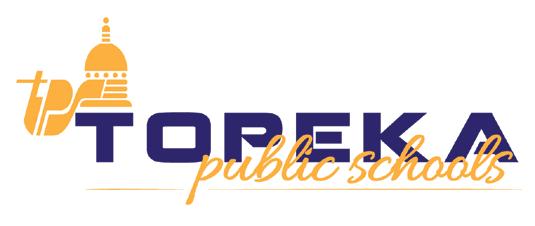
All students will demonstrate academic growth and will have equitable access to academic opportunities.
Outcomes:
• State-level assessments: Meet or exceed state benchmark standards
• Subgroup achievement: Implement system for data utilization, interventions, data driven instruction
• ACT composite scores: Implement ACT tutoring and testing during the school day to expand participation
• Kindergarten readiness: Open a new early childhood center in 2018-19
Ensure efficient operations and accountability for responsible use of district resources.
Outcomes:
• Facilities plan: Construct a staff development center, an early childhood center and a career academy as services for students and families across the community.
• Balanced budget: Maintain a balanced budget and secure corporate sponsors and grants
TOPEKA (KSNT) – State education officials say eight school districts across Kansas will be participating in a new pilot apprenticeship program.

The Kansas Department of Education (KSDE) announced in a press release that the Kansas Registered Teacher Apprenticeship program officially starts July 25. This new program is sponsored by eight Kansas school districts and will place 15 apprentices alongside experienced educators while they work toward their bachelor’s degrees.
“This is an important step to alleviating the shortage of educators we have in Kansas,” said Kansas Commissioner of Education Dr. Randy Watson. “It is a win-win situation for individuals who want to pursue teaching as a career, school districts that have a shortage of educators and our students who deserve a quality teacher in every classroom.”

The KSDE said the apprentices participate in lesson planning, curriculum development, instruction delivery and student assessments under the supervision of a paid mentor teacher. The mentors serve as guides and role models for the apprentice throughout the program, giving apprentices a chance to learn on their feet.
Participating school districts include:
• Salina Unified School District 305
• Wellington USD 353
• Lyons USD 405
• Dodge City USD 433
• Auburn-Washburn USD 437
• Tonganoxie USD 464
• Topeka USD 501

• Attica USD 511
“This is historic for the state of Kansas,” said Assistant Secretary of Commerce Mike Beene. “The registered teacher apprenticeship is a good way to engage existing talent in the state and keep
them here.”
This comes shortly after Governor Laura Kelly signed off on the Kansas Apprenticeship Act on June 30. She also recently announced the launch of MeadowLARK, an apprenticeship program funded by the State Apprenticeship Expansion Formula (SAEF).
To learn more about the Registered Teacher Apprenticeship program, you can reach out to Dr. Joel Gillaspie by phone at 785-296-1862 or send an email to jgillaspie@ksde.org.

T’Ajahnae Ray was a little fearful, but she did it anyway.
Ray had walked onto Washburn University’s campus for her first day of college, even though she was technically still a high school junior.
She was a girl of two firsts, as a member of the first group of students to enroll in Topeka USD 501’s College Prep Academy five years ago, and the first to pilot a program where a select number of the academy’s students essentially start college two years early.
“I was lost. I think I walked into the wrong classroom twice,” Ray joked about her first day at Washburn. “It was so big. … I had a whole schedule across a huge campus with different buildings.”
But despite any fear she had about starting college early, Ray knew she had the support system of Kathleen Foster, the academy’s teacher, as well as that of superintendent Tiffany Anderson, her parents and her College Prep Academy peers.
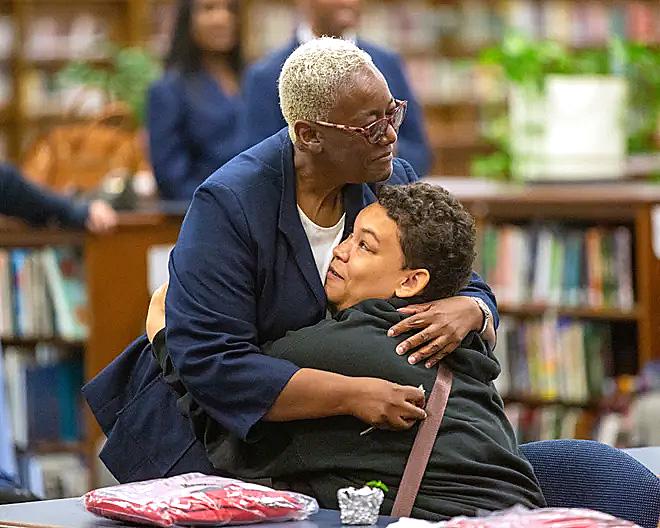
“They got me through it,” Ray said. “It may be rough. There may be challenges. But you are able to get through it, as long as you know it’s OK to fail. You pick yourself up, figure it out and learn to do better next time.”
She also had an intense focus on scholarship and professionalism she cultivated during the past five years of classes through the academy, preparing her not only for classes at college but also life after school.
So she did it anyway.
On Saturday, Ray and all but one of her peers who remained in College Prep Academy graduated with their high school degrees.
They are proof of the concept that such a program can work to improve college prospects for students who just need an extra nudge in one of the most diverse districts in Kansas.
College Prep Academy started five years ago, shortly after Anderson’s arrival to Topeka. To lead the program, she tapped Foster — a veteran educator who had worked with her while in Jennings, Missouri.
Although that initial cohort of 15 seventhgraders and 30 eighth-graders was the largest the academy ever admitted, cohorts have remained small in the five years since. Out of dozens of applicants and recommendations each year, the program only takes about 15 middle school students per year, Foster said, in a bid to keep class sizes low and personable.
The program specifically targets students who can excel at academically accelerated coursework but perhaps may not otherwise receive the support they need to get to college. Students must also have good attendance records and no reported disciplinary referrals.
Throughout their school careers, the College Prep Academy instructors work with students to make sure they’re excelling academically.
“We monitor grades weekly,” Foster said. “In middle school, it was easier, since we had them with us, and in high school, we’ve had to be more
proactive to check with them at their schools. We call them each week to figure out what supports they might need and make sure they do get those supports.”
Topeka’s College Prep Academy graduates set high professional standard
Beside the higher academic rigor, just as important for College Prep Academy students has been instilling in them a sense of confidence and voice in their capabilities, Foster said.
Even from middle school the academy focuses on establishing a sense of professionalism among the young teenage students, with eighth-graders receiving business cards to hand out at community events when introducing themselves to adults.
“We have students who came to us with no idea of their own capabilities,” Foster said. “They did not see themselves for who we saw them as.”
Of the students who remained in Topeka USD 501, all but one of the original cohort graduated
You can read the full article at: https://www.cjonline.com/story/news/education/2023/05/14/topeka-public-schools-college-prep-academy-graduates-first-cohort/70207665007/


In 2018, USD 501 Topeka Public Schools began College Prep Academy with 43 seventh and eighth graders. That first group from Eisenhower and Chase Middle Schools followed a rigorous course of study, working two grade levels above the traditional curriculum with year-round academic opportunities. The goal was to see them graduate high school with 30 to 60 hours of college credit or an associate’s degree, and a clear plan for their future.

One of those original students, Highland Park High School’s T’ahjanae Ray, will spend her junior year also as a freshman at Washburn University. Ultimately, she will graduate with both her high school diploma and liberal arts associate’s degree at the same time. The district has secured community partner donations to provide a full scholarship for Ray, who has also secured scholarships to complete her bachelor’s degree.
“I’m ecstatic,” Ray says of attending college. “So excited and a little nervous just because I’m the first, so I have a lot of pressure on me just to make sure I’m doing everything right. I want to set an example, and I want to show other students they can do this too.”
“This is a superstar in the making,” says Dr. Alan Bearman, Dean of University Libraries and the Center for Student Success and Retention at Washburn. Schools all over America want students just like this. We’re going to help her live her dream, and she’s going to be a star.”

The TPS College Prep Academy was the brainchild of District superintendent Dr. Tiffany Anderson, who implemented this type of program in her previous school systems. What began with middle school students has not expanded to the elementary level with the creation of Early College Prep Academy at Lowman Hill Elementary.
“I’m so excited not only for T’ahjanae but
for all the students she represents,” Anderson says. “She’s demonstrating that working at the highest levels of rigor in middle school and high school can lead to college opportunities very early. College Prep Academy also closes that economic gap for families who simply may not be able to afford college expenses. We take care of almost two years of college.”
Ray feels prepared for university studies. She will major in political science at Washburn
while staying involved in theater and other extracurricular activities at HPHS. Her plans include obtaining a law degree to help women in need.
“College Prep Academy was hard, but I feel like it made me a better student because it made me take charge of my own learning,” Ray explains. “It really makes you understand who you are as a student and what you need to grow and be strong academically.”
TOPEKA, Kan. (WIBW) -T’ahjanae Ray will be the first student to attend college in the fall, through a program created by Topeka public schools superintendent Dr. Tiffany Anderson.
The Washburn Early College Scholars Program is a partnership with Washburn University to help further students’ education.
T’ahjanae Ray received the opportunity to graduate with an associate’s degree and her high school diploma at the same time.
The Topeka Public Schools Early College Academy Program started in 2018, and Ray is the first student to take on the challenge.

“This will be a huge deal, I will be the first person in my family to go to college so be able to be the first person to start this early and have this first opportunity ever. I feel so honored as I can barely put into words how honored I feel,” she said.

District leaders surprised her with an acceptance letter at Highland Park Friday afternoon, and one other surprise.
“I had known about the program but I didn’t know anything about the scholarship and I know
how expensive college is,” Ray said.
Ray may only be a high school sophomore but she already has plans for when she gets her degree from Washburn.
“I want to go off to law school and after law school, I want to start a practice but I really want to help with women who have found themselves in
tough situations and I want to help them legally,” she explained.
Ray says she’s grateful for this program seeing the potential at Highland Park.
“There’s hidden talent and smart students here that don’t get the shot because of where they live,”.
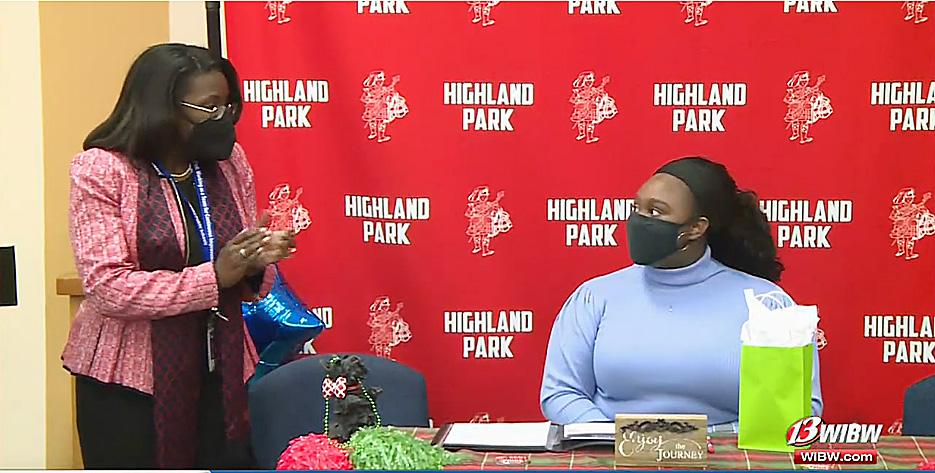
TOPEKA, Kan. (WIBW) - A second student from Topeka Public Schools has been admitted to college as a junior in high school.

Topeka Public Schools USD 501 says its Early College Academy will have its second 11th-grade student attend college full-time this fall.

TPS noted that the program created by Superintendent Dr. Tiffany Anderson was funded by TPS and finalized through a WashburnTPS partnership and an MOU with Washburn University.
The District and Washburn staff recognized junior, Carolyn Parker at the Topeka Center for Advanced Learning Careers at 9 a.m. on Friday, Aug. 19, for the accomplishment.

“The feeling is very similar to going to TCALC for the first time and just knowing that I could further my education and fast-track it just makes it all the better,” according to Parker.
TPS indicated that the unique program is called the Washburn Early College Scholars Program to help students attend college early. Dr. Anderson hopes to expand the program to other colleges.
According to USD 501, the program is meant to prepare students for college to apply for admissions at the end of their sophomore year in high school and gain acceptance. It opened in 2018 and the
rigor and the advanced level of coursework ensure students take the ACT as ninth-graders and gain a score meeting college admission standards.
TPS noted that students perform multiple grade levels above their actual grade level and the program is the only of its kind in the region.
The District also said it has secured partner donations to contribute to the cost of tuition that will provide the scholarship for the first student to attend. When 13 NEWS asked Parker how it feels
to have her education paid for her, she says it is crazy.
“It is honestly really shocking, to have an education is probably one of the most powerful things on earth, but to have it paid for...oh my gosh, it is crazy,” said Parker.
TPS indicated that Parker will graduate with her associate’s degree in liberal arts and her high school diploma at the same time.

Two prospective teachers from Topeka USD 501 high schools are among the best in the nation.

Sophomores Gabby Barron, of Topeka High, and Renae Easter, of Highland Park, placed in the national Educators Rising competition late last month in Orlando. The competition has students from across the country present lessons they’ve compiled as they’ve learned the basics of teaching.

Barron took second place in junior varsity for the lesson planning and delivery in fine arts category, while Easter took sixth in the Science, Technology, Engineering and Math category.
Both students are members and participants of USD 501’s Topeka Center for Advanced Learning and Careers’ Teaching as a Profession pathway, led by veteran teachers Robin Dixon and Diane Kimsey.
The pair of teachers, who took a contingent of USD 501 students to compete in Orlando, said the program continues to grow and prosper in the two years since they’ve taken over the program. Last year, two TCALC students also placed top 10 in the nation.
“We have high expectations for them,” Kimsey said. “We’re also very fortunate to have backgrounds that have to do with curriculum and in teaching professional development to all of the elementary educators in the district.”
“Our district is also very supportive of growing our own teachers for Topeka Public Schools,” Dixon said. “That’s been a big phrase at the conference — ‘Grow Your Own,’ or GYO. It’s a big part of the teacher shortage right now in working
to find teachers from within, and from kids who are already in our classrooms.”
Barron and Easter excelled in the competition, the teachers said, in large part because of their confidence and determination. Both are interested in one day teaching at the elementary school level, and they have also been offered tentative contracts to return and teach in Topeka USD 501 once they graduate college with teaching degrees.
Since taking over the program a few years ago,
Kimsey and Dixon said they have continued to see interest in the program grow. Their first year, they had only about a dozen students between the two of them. But they expect about 50 this coming school year.
“We’re continuing to grow,” Dixon said. “We already have some new plans for next year, and we’re excited. Our goal is to continue this program so that we can keep having excellent teachers in the future.”
TOPEKA, Kan. (WIBW) - A Topeka TOPEKA, Kan. (WIBW) - Area schools will soon welcome the state’s first-ever teacher apprentices as Kansas launches a new pilot program to put educators on the fast track.
The Kansas State Department of Education says that 15 aspiring teachers will head to classrooms across the state with the help of the Kansas Registered Teacher Apprenticeship program, which kicked off on Tuesday, July 25. The apprentices have been sponsored by eight school districts and were introduced to the pilot program during a workshop held by the Dept.
Officials noted that the program combines endurance and training of a registered apprenticeship with specialized education for those who want to become teachers. During the 4-year program, the apprentices will work alongside an experienced educator as they serve in a real classroom while earning a bachelor’s degree in a teacher training program at an accredited university or college.
“This is an important step to alleviating the shortage of educators we have in Kansas,” said Kansas Commissioner of Education Dr. Randy Watson. “It is a win-win situation for individuals who want to pursue teaching as a career, school districts that have a shortage of educators and our students who deserve a quality teacher in every classroom. The Kansas State Board of Education and KSDE are pleased to partner with the Kansas Department of Commerce to offer this opportunity.”
KSDE indicated that a teacher apprentice will aid in lesson planning, curriculum development,
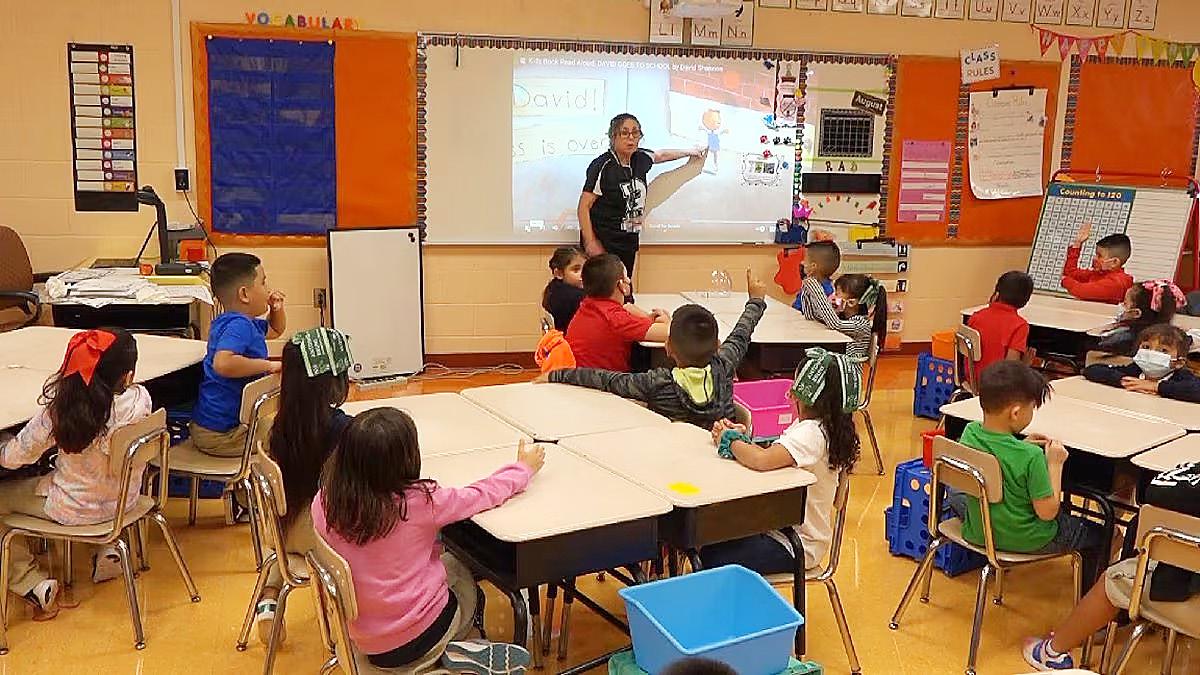
instruction delivery and student assessments under the guidance of a paid mentor teacher. The mentor teacher wills serve as a guide and role model throughout the program. This will allow the chance to see experienced educators in action and collaborate and learn from colleagues. Gradually, the apprentice will take on more responsibilities as they progress.
School districts set to participate in the pilot program include:
• Salina Unified School District 305.
• Wellington USD 353.

• Lyons USD 405.
• Dodge City USD 433.
• Auburn-Washburn USD 437.
• Tonganoxie USD 464.
• Topeka USD 501.

• Attica USD 511.
Officials noted that the program will ensure administrative processes are in place to open a statewide program for the next school year. Districts who participate in the program will be awarded grants to cover the college or university tuition for the apprentice, half of the apprentice’s wages and mentor teacher awards.
“This is historic for the state of Kansas,” said Assistant Secretary of Commerce Mike Beene. “The registered teacher apprenticeship is a good way to engage existing talent in the state and keep them here.”
For more information about the registered teacher apprenticeship, click HERE.
The Shaner Early Learning Academy staff couldn’t help but burst into tears and cheers as they were introduced to their newest preschool teacher earlier this year.
After the preschool center saw higher than expected enrollment, principal Regan Baxter needed to open another classroom. But who would lead it?
Baxter had just the person in mind, and she wouldn’t even be new to the academy.
Angelia Gay, a longtime paraprofessional in Topeka USD 501 schools who holds an emergency substitute license, was asked to step in and lead her own classroom this year after helping another teacher in the building.
It’s an informal part of Gay’s training as she participates in a partnership program between Washburn University and Topeka USD 501 to help paraprofessionals earn their teaching licenses.
As schools around the state and country look to new approaches to challenges in finding and hiring teacher candidates, districts like Topeka USD 501 are looking at some of the best talent they already have but who may not have full teaching credentials.
Washburn partnership is helping paraprofessionals get degrees
Gay is one of about 15 Topeka USD 501 this year taking classes through Washburn University’s Paraprofessional to Teacher Program, which aims to help the district “grow its own” set of future educators.
Paraprofessionals who have been with the district at least one year have the chance to enroll in teacher preparation classes at Washburn, while they continue working in the district in their current jobs or as longer-term substitute teachers.
While the program has been in place many years, the program has become much more convenient for paraprofessionals who participate with the university adjusting courses to be offered outside of school hours and increasing its financial aid offerings.
“It didn’t used to be that way,” said Nicole Johnson, human resource director of certified personnel for Topeka USD 501. “Our paras used to have to leave during the work day a few times a week. But Washburn has rearranged their class schedules and made them so much more accessible. They understand that young people
can’t just quit working.”
“It helps people get back to school who maybe couldn’t before because they did have families, and they need incomes,” Johnson added. “It’s been a game changer.”
Students in the Paraprofessional to Teacher program also receive credit for some of their practical experience of having already worked in a classroom — which is a boon for the prospective teachers in getting their degrees and licenses much faster.
For Gay, the new preschool teacher, education always seemed like her end goal, especially since she’s from a family of career educators.
She found great value in her job as a paraprofessional at Shaner and other Topeka USD 501 schools, often doing much of the same work as the teachers she assisted.
Topeka
Johnson said as schools explore new avenues to address teacher shortages, Topeka USD 501 has found some of its greatest assets are its existing paraprofessionals.

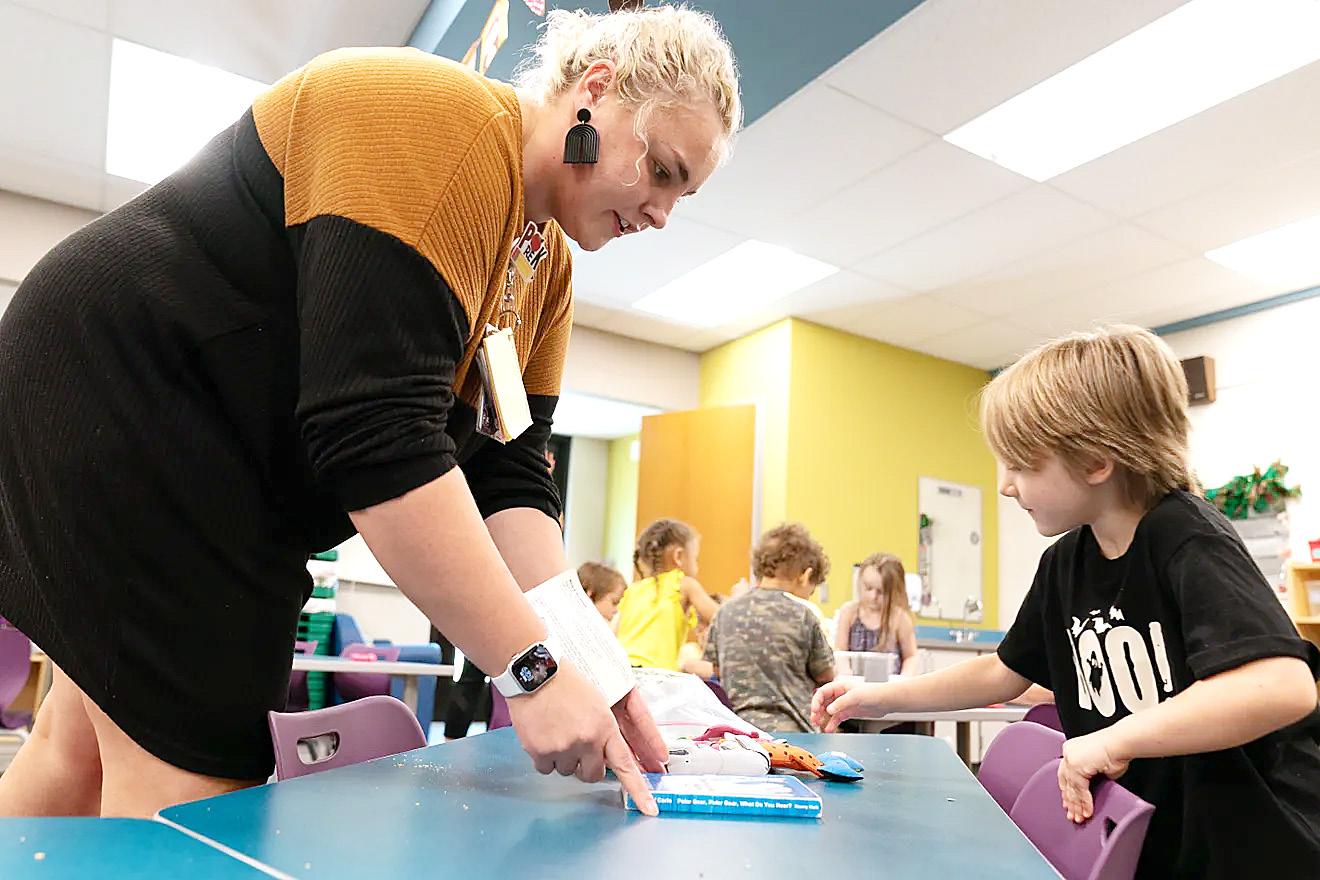

“There’s a crisis of young people going into teaching, and they only last one or two years,” Johnson said. “(You think) anyone can go to school and become a teacher, but that’s not true. The demands are intense. It’s a really tough job. But our paras have been walking the walk for many years. They know it, they see it and they’re hand-in-hand with our teachers, so when they make that commitment to go to school, they stay.
“They get that degree, and they won’t change professions.”
“My goal as a para was always to support my teacher, and to make sure anything they needed was taken care of,” Gay said. “I was supporting my students, I was running small groups, I was de-escalating. I was still teaching, but under a different title. That’s where that experience comes from. I was getting to do that in a classroom already, but now I get to move up.”
While she imagines that she eventually would have found a way to earn her teaching degree, she knows it would not have been nearly as fast without the help of the partnership program. In addition to working at Shaner and studying at Washburn, Gay is a full-time mom at home, she said.
“(The program) made me feel like I could do this — not just the program, but the people,” she said. “I felt capable, like I could afford it, and that I could still be there for my family and work this job.”

MANHATTAN, Kan. (WIBW) - The Kansas State University College of Education received a grant to recruit and mentor new teachers to combat the teacher shortage.
Kansas State University officials said the federal grant will bring its teacher education program to local school districts and community colleges in an effort to combat statewide and national teacher shortages.
K-State officials said the $2.6 million project aims to create an education pipeline for underserved and place-bound students planning to become teachers in three Kansas school districts and three community colleges.
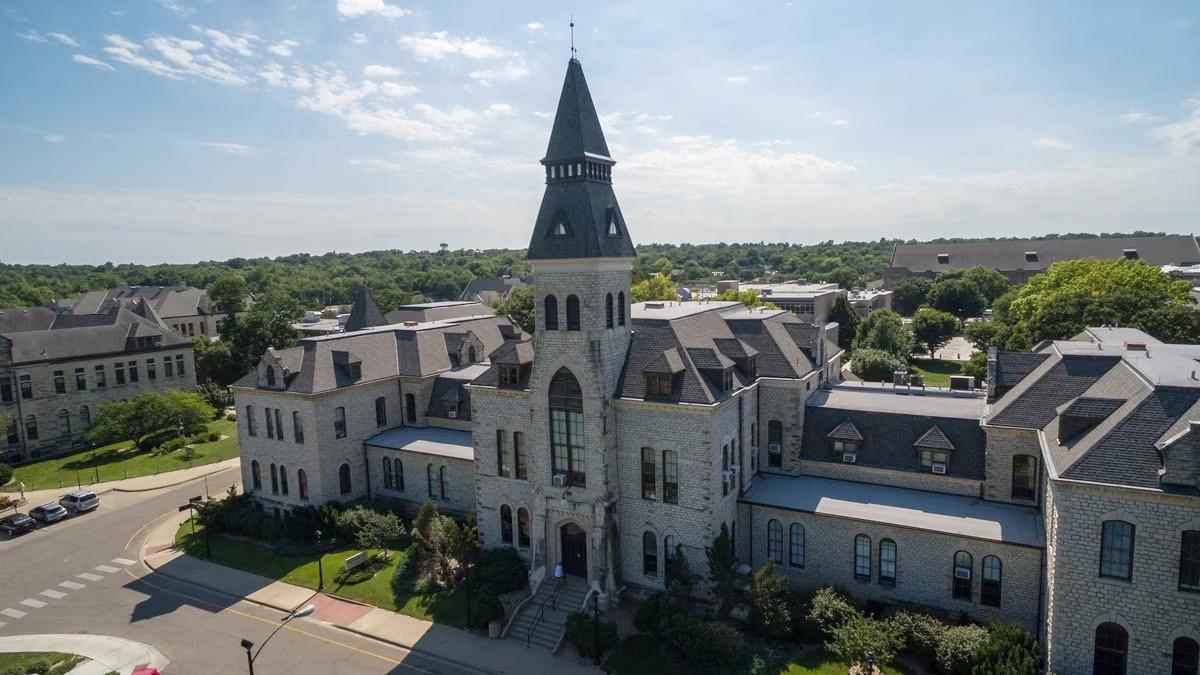
According to officials with K-State, the fiveyear grant, Project REFORM - an acronym for Redesigning Experiences Forging Opportunities for Recruitment and Mentorships - is funded through the Teacher Quality Partnership grant from the U.S. Department of Education’s Office of Elementary and Secondary Education.
K-State officials said Project REFORM is a collaborative effort among the College of Education and College of Arts and Sciences at K-State, Topeka USD 501, Allen Community College, Independence USD 446, Independence Community College, Coffeyville USD 445, and Coffeyville Community College.
“We are so proud to work with local educators to bring K-State’s award-winning teacher education program to Coffeyville, Independence and Topeka,” said Debbie Mercer, dean of the College of Education. “There are many amazing students who want to become teachers and contribute to their home communities, and we are excited to be the trusted higher education partner in this collaboration.”
K-State officials indicated the project is designed to reach underserved students and focuses on the three school districts, which serve 16,272 students. Each partner will play a key role in supporting the reimagined community college and university teacher education pathways that streamline the educational journeys for students who are economically challenged or place-bound.
According to K-State officials, included in Project REFORM’s main components is a clinical internship that extends the amount of time teacher candidates spend in classrooms from a semester to a full year. The project also includes a mentor teacher academy to provide additional support for the teacher candidates.
“Project REFORM is our second Teacher Quality Partnership grant leveraging our online

undergraduate degree program in elementary education in collaboration with Kansas school district and community college partners,” said Todd Goodson, associate dean of the college and lead investigator for the project. “We believe this is critically important work that addresses the need to diversify our teacher force and respond to the current teacher shortage.”
K-State officials noted in addition to Goodson, three K-State faculty members are co-principal investigators for the projects - Tonnie Martinez, coordinator of the office of innovation and collaboration; Eileen Wertzberger, director of field experiences; and Lori Goodson, assistant director of the Rural Education Center.

TOPEKA, Kan. (WIBW) - The USD 501 school district has some new teachers for the 20232024 school year, and both say they are excited to promote cultural diversity.
Shelamie Santillan and Missi May Flores will join USD 501 because the pair heard good things about 501’s cultural diversity. Both Flores and Santillan have a Filipina background.
“I can see that this is a diverse district. As a cultural exchange teacher, it is an opportunity for me to promote awareness of cultural diversity,” said Flores. “I think it will be good to introduce that at that early age.”
Cherryl Delacruz, a high school math teacher at College Prep Academy and secondary math consultant for the district, was acting as a mentor for the two teachers and told 13 NEWS Topeka Public Schools created a partnership with Filipino teachers in the Philippines to recruit them to teach in America and that is how Delacruz was recruited into Topeka Public Schools.
“About 15 years ago, I was only looking for ‘a greener pasture’ to help my family financially,” said Delacruz. “There was an opportunity that came because a lot of districts from the United States, I am talking about a lot, like plenty of districts went to the Philippines to recruit teachers in critical areas like science, math, and special education, and so I grabbed that opportunity, and when I started teaching here, this became home. I have had several chances to teach in other countries and go back to the Philippines, but Topeka became home for me.”
Delacruz said Santillan and Flores are highly qualified, outstanding teachers that underwent a licensing process to teach in Kansas. She had some advice to share with the new teachers: the transition will be challenging, yet an entire system of people is here to help.
“Transition is going to be a little difficult. However, we have tons of support and a system of support here at Topeka Public Schools,” said Delacruz. “School level, classroom level, district level; you have everything you need. Please reach out to your principal, your coaches, [and] your co-teachers, they are always going to be there, and to the district, they are always going to be there for you and to help you. Relationship building is essential in this profession. Building positive relationships with your students, teachers, families, and other staff members will take you a long way.”

According to Delacruz, USD 501 has approximately 30 Filipino teachers in the district.
The two teachers are initially from the Philippines, but both traveled from Minnesota after Flores previously taught at a Minnesota school during the 2022 - 2023 school year.
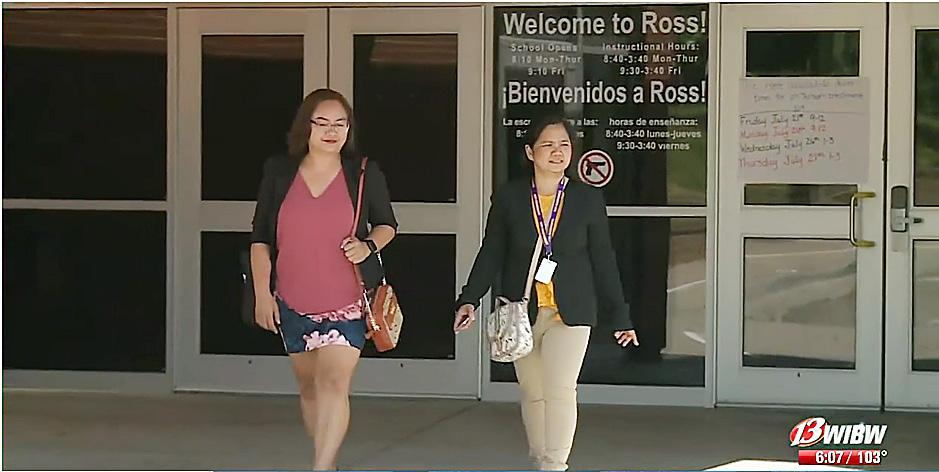
“When [Flores] applied here at Topeka Public Schools, I shared it with my friend ‘Shela’ [Shelamie], and she is also interested in knowing that it is a diverse district. I told her, ‘There are a
lot of Filipinos there,’ and we are so excited to be a part of the district, so then she applied as well, and then we moved here together,” said Flores.
Santillan said she would feel homesick. But she views joining the USD 501 district as an adventure, a chance to make new friends, learn new things, and see new places. Although Santillan wanted to ask the parents to help her out now and then, rest assured she will care for their children.
“Your children are in good hands,” said Santillan. “Your children are my children. Please know that I feel you. I have children too. So, I need your partnership with me. So, when I call you, please be there. So, when I am going to text you, please answer so that we have good communication for the development, for the welfare of your children. I will love them as my own.”
Santillan and Flores will teach a third-grade class at USD 501’s Ross Elementary for the upcoming year. The USD 501 2023 - 2024 school year starts the second week of August (August 8-9). Preschoolers’ first day of school will be Monday, August 17.

Oh, how the nerves and anxiety felt in the pit of Yecytl “Yessy” Velazquez’s stomach.
She stood there, dressed in the red cap and gown, in front of her 5-year-old son Brandon Joel Velazquez, dreading the walk she would take across the stage to receive her high school diploma in front of a crowd of people.

Velazquez, 22, had never been very keen on being in front of large groups of people. She’d never been too keen on school, either.
But as she looked at Brandon, she knew that years of struggles to learn English, go back to school and finally earn her high diploma would all be worth it if it gave her son even a fraction of a better chance to live a better life.
Despite the odds stacked against her and her family, Velazquez earlier this month graduated from Topeka USD 501’s Avondale Academy, an alternative high school that allows students to take online classes and catch up or recover any credits they still need to receive a diploma.
The school has traditionally worked with students who have not found much success in more traditional school environments. They often fail to find it at Avondale, as well. But for students like Velazquez who can persevere through their individual challenges, Avondale, and other supporting programs, have the capacity to change life trajectories.
Although born in Atlanta, Velazquez was mostly raised in Mexico. It was there that she grew disillusioned and disengaged with school, and she dropped out at 16, moved to Arizona and had her son there.
When she moved to Topeka, she began working at Reser’s Fine Foods. That’s where she learned about the Kansas Migrant Education Program and met Melanie Stuart-Campbell, an instructional specialists and advocate for the program, as well as a Topeka Board of Education member.

While the program does ostensibly work with migrants, Stuart-Campbell said that can be a misnomer. In reality, the program works with children and youths in families that work in
agriculture-related fields, including Reser’s, and have often moved for that work.
When Velazquez’ son moved to Topeka with her, that’s when she realized she should get more serious about her studies. After a failed GED test attempt, Stuart-Campbell helped Velazquez enroll in the Migrant Education Program’s Portable Assisted Study Sequence program, which helps highly transitory migrant children earn and meet credit requirements that can apply to most high schools in participating states.
Taking a look at Velazquez’s transcripts, StuartCampbell realized that she had already met quite a few graduation requirements. When she did as much as she could through the PASS program, Velazquez enrolled in Avondale Academy, where learning how to take classes online was a huge learning curve.
“Her dedication to her family, her education and her job is unwavering,” said Michelle Lucht, a virtual coordinator at Avondale. “It’s difficult to balance all three, and some students will try to pass classes very quickly with minimal effort when life gets busy. That’s not Yessy. She devoted
30 to 40 hours each week in class to make sure she understood the material, all while raising a child and working. … I think her dedication is extremely admirable, and her time management and self-advocacy skills are very high.”
Velazquez hopes to start a automotive shop by a woman and for women
Additionally, for the past semester, Velazquez has been taking automotive technology classes at Washburn Tech, with Avondale Academy helping pay for her tuition.
Velazquez was inspired to enroll after being ripped off on a car repair, and she wanted the independence to repair her own car whenever needed.
“Yessy can do anything she wants to do,” said Craig Carter, one of Velazquez’s teachers at Avondale. “She has that drive and determination, and the sky is the limit for her.”
Velazquez is still working on finishing that associate’s degree, while she looks for grants and scholarships to help pay for it. She’s also working to raise enough money to pay for a lawyer to help her mother, Yolanda Suárez García, and her
 By Rafael Garcia Topeka Capital-Journal
By Rafael Garcia Topeka Capital-Journal

More than 30 Ukrainian refugee students are wrapping up their first full school year in Topeka USD 501, and by all accounts, the year has been successful.
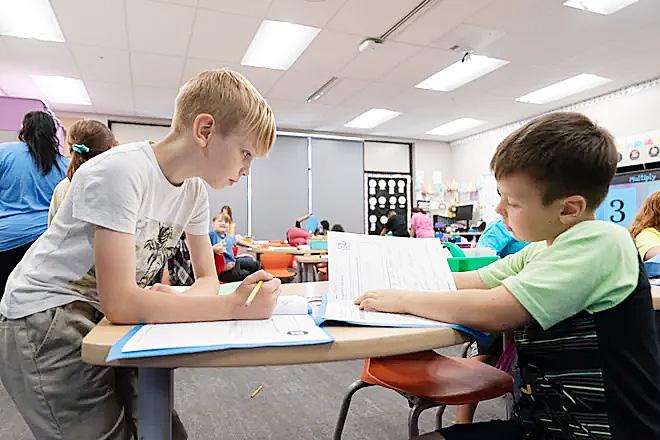
Pilar Mejia, director of cultural innovation for the district, gave an update to the Topeka Board of Education on Thursday.
Several families have cycled through the district over the past year, and eight parents have even found employment through the district, as USD 501 looked for ways to support the families.
“They’re really happy, and they’re happy with the supports,” Mejia said. “They’re not as intensive as before… but it’s just wonderful to see how we have created this community of support and just growing in culture.”
While intensive, daily support for the families is no longer as necessary, Mejia said the district had learned lessons it could apply to working with future refugee families — from Ukraine or otherwise.
Much of Mejia’s work in her first year as cultural innovation director has been figuring out how to best need the culturally diverse needs of various students groups, such as the Ukrainian students and student speakers of other languages.
More Topeka USD 501 students recognized for bilingualism
Mejia also updated the board on the number of students who have earned the Seal of Biliteracy through the Kansas State Department of Education. To receive the seal, which is both an honor and certification of a student’s multilingual proficiency, students must score at least “proficient” on exams in both English and another language.
Compared to the 2021-22 school year, Topeka
USD 501 was able to practically triple the number of seniors who received the Seal of Biliteracy to 45, with students demonstrating proficiency in English, Spanish, French, Ukrainian, Tagalog and Swahili.
Underclassmen may also test and meet the requirements of the seal, but the award is not formally conferred until the students’ senior years.
Mejia credited the increase to focused awareness and testing campaigns at the district’s three main high schools. The district worked to identify all students who might be interested in the
seal — such as English-language learners, students who speak a language other than English at home, and students in world languages classes.
Students also have the ability to retest once per spring semester, and Mejia believes interest in the seal will continue to grow.
“It is a privilege and a huge honor to have something that confirms their bilingualism, their biliteracy or more,” Mejia said. “(It increases their) employability, pride and so many other benefits that come with that.”
 By Rafael Garcia Topeka Capital-Journal
By Rafael Garcia Topeka Capital-Journal

Kansas state assessment scores are out, at least to schools, and in Topeka USD 501, signs of progress also still show a high amount of students who are scoring at levels considered below grade level.
The Topeka Board of Education on Thursday heard a presentation on the preliminary English language arts and math scores for students who took the annual test in April.
Compared to the past few years of COVID-era learning, many schools — especially elementary schools that had already been among the lowest performing in Topeka — saw positive movement in reducing the numbers of students scoring below grade level.
What do levels mean on Kansas state assessments?
In Kansas, schools are legally required to give annual state assessments in English language arts and math to third through eighth grades, as well as 10th grade.

Students’ raw scores on the assessments are then turned into a scale score that ranges between 220 and 380. This range is further divided into four category ranges, which differ across grade levels and subjects.
Students who score in the level 1 ranges show “a limited ability to understand and use the skills and knowledge needed for postsecondary readiness.” That’s compared to levels 2, 3 and 4, which indicate basic, effective and excellent abilities, respectively.
Kansas State Department of Education officials have cautioned against using the state assessment categories as indicators of students being above or below grade level.
In Topeka USD 501’s presentation Thursday, officials defined level 1 as being “below grade level” and grouped levels 2, 3 and 4 as simply being “on or above grade level.”
Data is still preliminary and subject to change. Full results, including at the statewide level, aren’t usually released to the general public until later in the fall.
What Topeka USD 501’s 2023 state assessment scores say
More than a third of students at Randolph, Meadows, Lowman Hill, State Street, Scott, Jardine and Quincy Elementary schools scored “below grade level” on the English language arts assessment. Half or more of students at Williams,
Highland Park Central and Ross elementary schools scored “below” grade level.
Scores on the math assessments were relatively better, with most elementary schools having fewer students score at level 1, at least compared to the English language arts scores.
At the secondary level, most middle and high schools had at least half of students score “below grade level” on the assessments.
Some Topeka USD 501 schools had fewer students ‘below grade level’
USD 501 officials said the results more or less lined up with expectations. They pointed out the context that many of the lower performing schools also have disproportionate numbers of low-income and special education students, who face additional challenges in achieving academic success.
What has been promising, though, is seeing lower percentages of students who score in the level 1 category at certain schools, particularly the schools with higher numbers of at-risk students, on one assessment or the other.
District officials credited that movement to focused intervention efforts for struggling students. Those efforts include scaffolded instruction, in which lessons are easy to understand for students
of all levels of ability and understanding, and small-group instruction.
As far as the high school scores, district leaders also said that many students stop taking the assessments as seriously, and that’s been the case for years. Students who otherwise are straight-A students and score well on ACT and AP classes often fail their state assessments, largely because of a lack of effort.
How Kansas state assessment scores are used
As assessments meant to be used more at the classroom, building and district levels, the assessment scores by themselves have little bearing on any one student’s learning.
But Topeka USD 501 leaders and teachers combine those scores with other data sets collected throughout the year to figure out what students’ needs are and how to respond to those needs.
Those responses may include the scaffolded or small-group instruction strategies, or maybe focused training and professional development for teachers.
How to check your Topeka USD 501 student’s state assessment scores
Although school- and district-wide datasets aren’t available until later in the fall, parents may already access their individual students’ state
 By Rafael Garcia Topeka Capital-Journal
By Rafael Garcia Topeka Capital-Journal

The first students Manaia Isaia and Ainsley Schimmel ever had were stuffed animals.
“I would line up my stuffed animals in a room, use my lamp like one of those old school projectors, say ‘OK, class,’ and hand out papers on the floor to all of my ‘students,’” Schimmel said with a laugh.
Isaia even remembers video-conferencing in a friend — before it was cool — to help teach her fuzzy friends as an elementary school student.
These were the two Topeka West students’ first brushes with the field of education, and each one’s memories played a role in piquing the students’ interest in the Teaching as a Profession pathway at the Topeka Center for Advanced Learning and Careers.
But never did Isaia or Schimmel ever imagine they’d have the chance to share that passion on a national stage.
The two students each qualified for and placed in the top 10 students for STEM lesson planning and delivery at the National Educators Rising conference this past weekend in Washington, D.C.
“They’re great kids, and this was their moment to shine on a national stage,” said Diane Kimsey, the students’ Teaching as a Profession teacher. Kimsey accompanied the pair to the four-day conference.
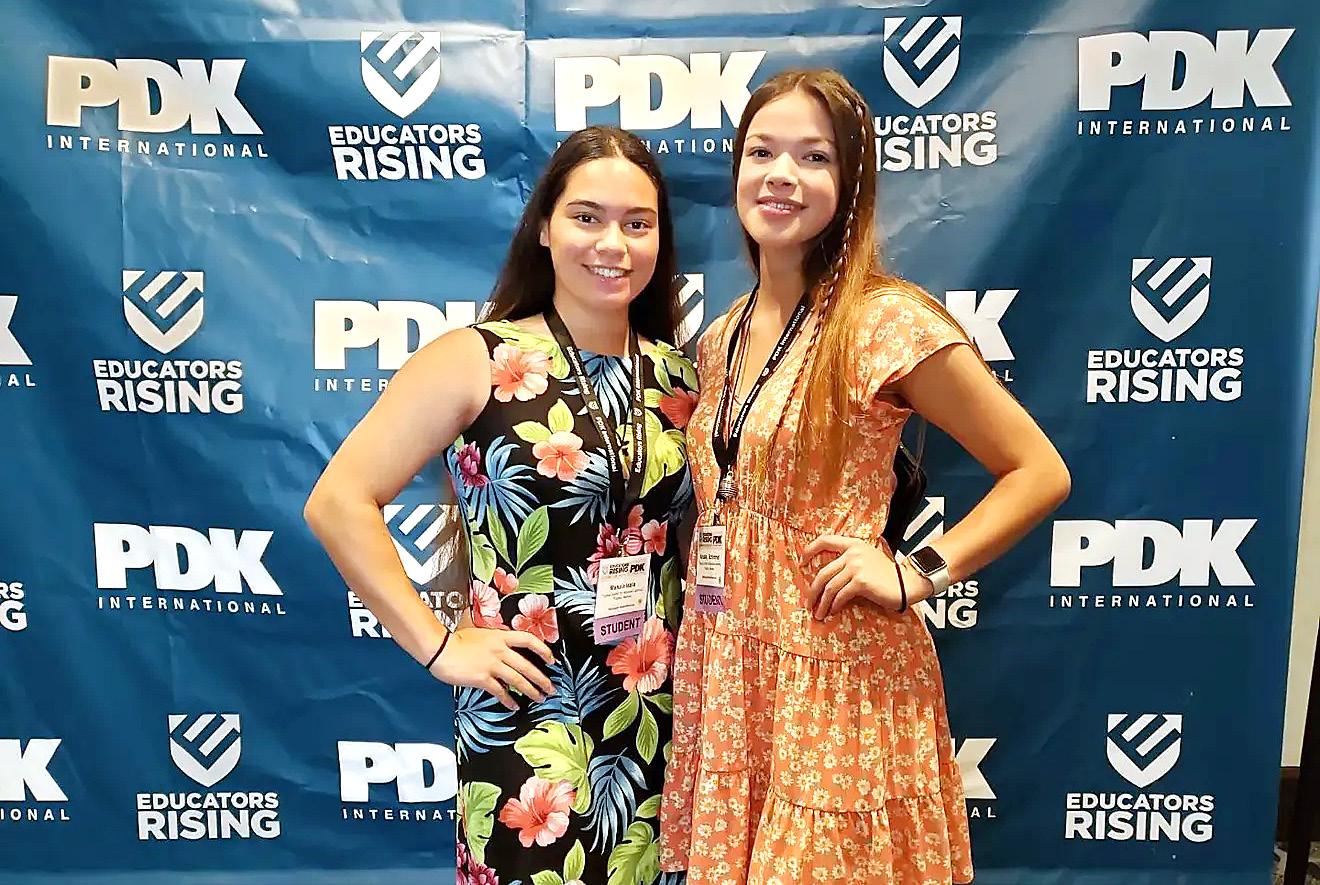
Before they walked into the ballroom packed with 2,000 high schoolers all set on becoming future educators, Kimsey took a second to let the two students get ready for the moment.
Over the course of the past year and under Kimsey’s wing, Isaia and Schimmel had become a part of a small family of TCALC students learning from and inspiring each other to be teachers.
Teaching, it turns out, is much, much more than speaking in front of a group of kids, although that’s a portion of it. Through the course of Kimsey’s class, the Teaching as a Profession students learned that a well-designed and well-executed lesson can not only teach students — it can change their life trajectories.
The goal, then, is to do for future students what their teachers have done for them.
“I don’t remember everything I learned in elementary school, but I remember the teachers’
names that I connected with and made a difference like they made a difference in my life,” Schimmel said.
In preparing for the Educators Rising conference, Isaia and Schimmel, as well as their other classmates, prepared STEM lesson plans, using state education standards and presented those lessons to students at Meadows Elementary.
Isaia had students had students learn about potential and kinetic energy using a marshmallow catapult to save a princess, while Schimmel taught students about density by having them use a small rowboat to save a gummy worm.
In competition, panels of judges reviewed the students’ lesson plans and recordings of lesson delivery, while also asking the students questions about their work. Isaia and Schimmel soared through regionals in November and placed first and second, respectively, at the state competition in February, qualifying them for nationals in June.
It was this journey the pair of students reflected on as Kimsey opened the door and showed them a ballroom full of students just as eager to teach as they were.
“Manaia and I kept looking at each other, thinking, ‘We’re in Washington, D.C., right now
competing at nationals,” Schimmel said.
What it means to be a teacher
Beside competing, the students and Kimsey got to meet with high school students from all around the country and attend workshops on becoming effective teachers.
They also spent spare time touring landmarks around the country’s capital — experiences they hope can one day inform the way they teach.
“It stepped up my knowledge of what teaching can be,” Isaia said. “It was about seeing other people from around the country and learning about why they want to be teachers.”
Kimsey, who just wrapped up her first year leading one of the two Teaching as a Profession sections, and her counterpart Robin Dixon were also honored at the conference as being among of the top teacher leaders in the nation.
Tim Murrell, the retiring TCALC principal, said Kimsey and Dixon have been instrumental in building up the program.
“They are master teachers who have been able to come in and teach these kids what teaching is all about, from the ground level on up,” Murrell said.
“Without this pathway and without our teacher, we wouldn’t be learning about this profession, we
 By Rafael Garcia Topeka Capital-Journal
By Rafael Garcia Topeka Capital-Journal

For Gabriel Davis, there are few things that can compare to seeing a kid’s face light up when something finally clicks for them and he’s able to teach them something new.
It’s like a three-point buzzer beater to take the NBA Finals. It’s like Disneyland.
It’s joy.
“There’s something about teaching that just gives me joy,” the Highland Park High School junior said. “I love doing it, and I enjoy it so much.”
Davis and about a dozen other Topeka USD 501 juniors and seniors are part of the Teaching as a Profession pathway at the Topeka Center for Advanced Learning and Careers.
The pathway, as one of several career programs offered at the center since it opened in 2018, has churned out classes of new prospective teachers in the four school years since.
But even though they’re still students themselves, the Teaching as a Profession students are already finding a way to change younger students’ lives as future educators.
This year, students in Diane Kimsey’s and Robin Dixon’s Teaching as a Pathway classes have been busy, using the lessons in the class not only as an opportunity to learn about pedagogy but as a chance to teach others in the district.
In the fall, the TCALC future teachers led more than 3,000 of USD 501’s fourth-, fifth- and seventhgraders in science, technology, engineering and mathematics classes at the Kanza Education and Science Park.
Ainsley Schimmel, a junior at Topeka West, even had the chance to teach her 11-year-old sister.
“It was so cool seeing her answer these questions about subjects she didn’t learn from a textbook,” Schimmel said. “She learned them from an activity I got to lead and teach her.”
The future educators are also members of Educators Rising, an initiative of the National Education Association teacher’s union to develop teachers in U.S. high schools.
Through that organization, the students have participated in regional and state teaching competitions against other schools. They
developed lesson plans, recorded themselves presenting those lessons to students at Meadows Elementary and compiled reflections on their lessons.
“In our lesson plans, we had to have our standards put in, our teaching directions, classroom management, materials — pretty much anything you think you might need to teach that lesson or have a substitute teach the lesson,” said Athena Stiles, a junior at Topeka High School.
Manaia Isaia, a senior at Topeka West, took first place at the state competition earlier in March, with Schimmel taking second. Both will head to the national Educators Rising competition in Washington, D.C., in June with Kimsey, who also is a math consulting teacher for USD 501.
This semester, Kimsey’s class has also volunteered in giving STEM lessons at the Kansas Children’s Discovery Center every Wednesday, leading children at the museum in activities teaching concepts like engineering and chemistry.

The class is also working on putting together interactive video field trips to places around the city and state as part of their unit on project-based
learning. Those interactive videos will later be made available to students across the district.
And this week, the students will record themselves reading children’s books. They’ll then put QR codes of those videos in books at local elementary schools for students to use when they have trouble reading or comprehending books by themselves.
Mostly, the class has focused on learning how to teach beyond the textbook, instead opting for interactive lessons using objects like pencil catapults or higher tech robots that students can program to dance or follow instructions. Kimsey’s class has used lessons from a book called “Ditch That Textbook,” which prioritizes hands-on activities.
“It’s not about actually throwing away the textbook, but it’s about learning how to apply it to something the kids can relate to — giving them a reason why they are learning and then giving them something they can put their hands on,” Kimsey said.
The next generation of teacher Military kid. Dancer. Band geek. Classroom

When De’Aja’Nay Keeling walked across the high school graduation stage in mid-January, she wasn’t sure yet of her exact post-graduation plans.
But by the next week, her teachers and school leaders made sure she had a job as a colleague.
Amid a labor crunch affecting schools across the state, Topeka Unified School District 501 is turning to some of its 110 students who graduated in the middle of the school year to fill some desperately needed positions in the district.
At the district’s three high school graduation ceremonies, superintendent Tiffany Anderson set up interviews and jobs for 10 of the students to serve in classified positions such as receptionists, paraprofessionals and custodial and cafeteria helpers.
“Our job is to serve them and to make sure that doors are open for them — that they have access to opportunities,” Anderson said.
Topeka USD 501 has hired 60 additional substitute teachers

While levels have improved over the past few weeks, the district had struggled to staff schools between unfilled positions and workers not attending because of COVID-19 quarantines, in addition to regular staff absence reasons.
Anderson told the Topeka Board of Education on Thursday that at one point, the district had around 200 staff vacancies out of about 2,500 total positions across the district.
Since the Kansas State Department of Education loosened substitute teacher requirements to allow anyone older than 18 with a high school diploma to receive a license, Topeka USD 501 has also hired about 60 more substitutes, said deputy superintendent Larry Robbins, with some recent graduates working as early childhood classroom substitutes.
With the district facing high workloads for its school nurses, Anderson reached out to Keeling, who graduated from Highland Park High. Keeling
had received her certified nursing assistant certification after taking Washburn Tech classes paid for by the district.
“It’s just so special that they gave me this opportunity to work right after high school,” Keeling said, “and it’s been a bonus that my siblings go to school here, and I get to see them in the morning or maybe when they walk past the nurse’s office.”
At Jardine Elementary School, Keeling helps the school nurses with contact tracing and talking families through quarantine and isolation requirements.
New hires taking load off staff
Principal Angela Pomeroy said the presence of newly hired staff like Keeling has taken an immense load off of the backs of other employees, like school nurses who became overwhelmed
by higher COVID-19 caseloads in January, in addition to regular nursing duties.
“Our nurses have gotten so much stress of them since De’Aja’Nay started,” Pomeroy said. “They’re smiling, they’re happy and they’re caught up on their workloads.”
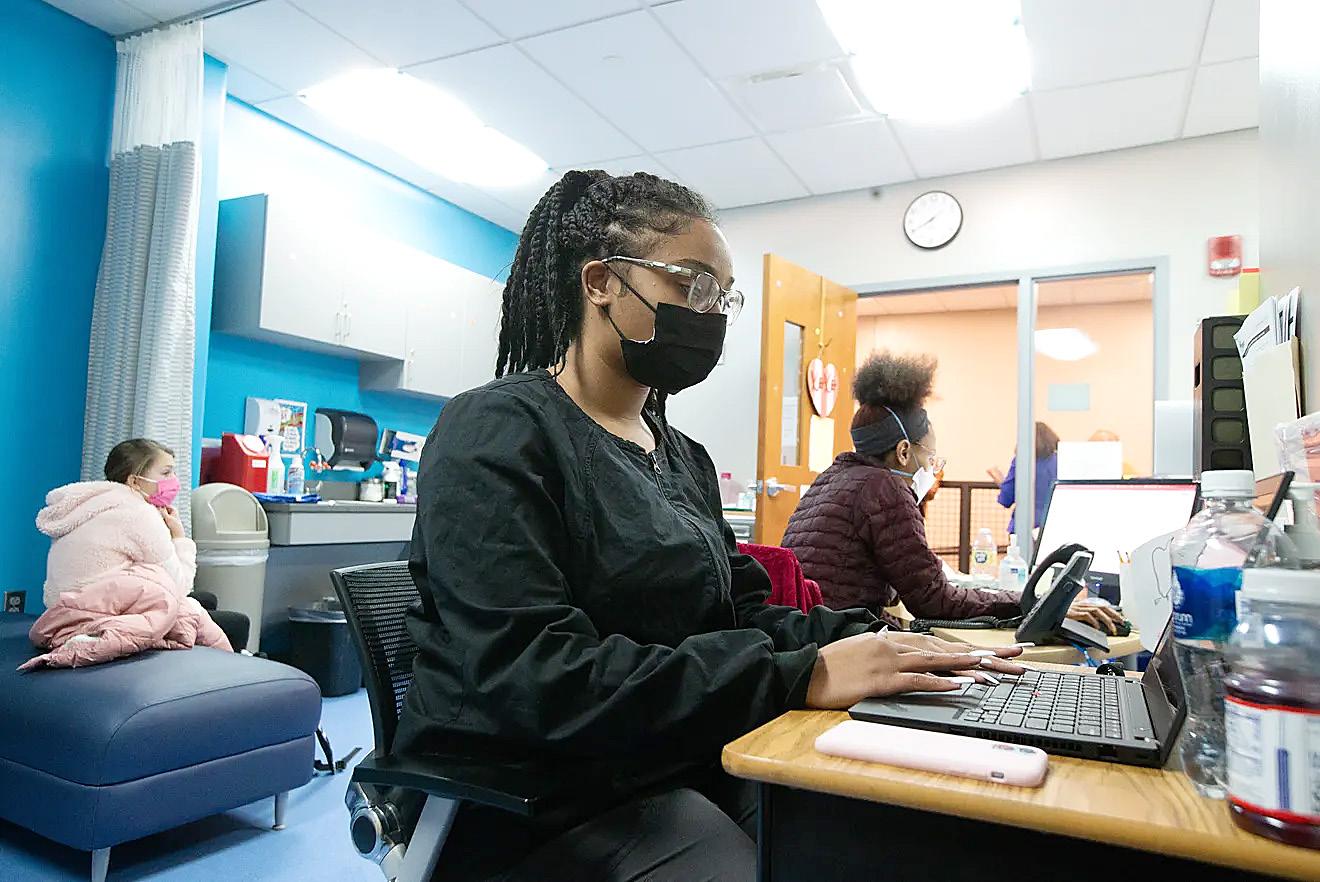
Long term, Keeling said she probably doesn’t want to work in a school setting. She’s starting phlebotomy classes this semester, alongside her job as a health aide, with plans to attend Washburn University in the fall to study to be a registered nurse.
But one day, when she’s a nurse in a hospital, she’ll look back gratefully at the career start Topeka USD 501 gave her, Keeling said.
“Working here has been so good,” she said, “because it’s giving me some great learning experiences.”
Over the last 12 months, Nataliia Mostova has gone from teaching in Dnipro, Ukraine, to working in a hotel in Bulgaria, to now serving as a paraprofessional at Jardine Elementary School in Topeka, Kan., where she’s helping young Ukrainian refugees get used a new life and school halfway around the world.
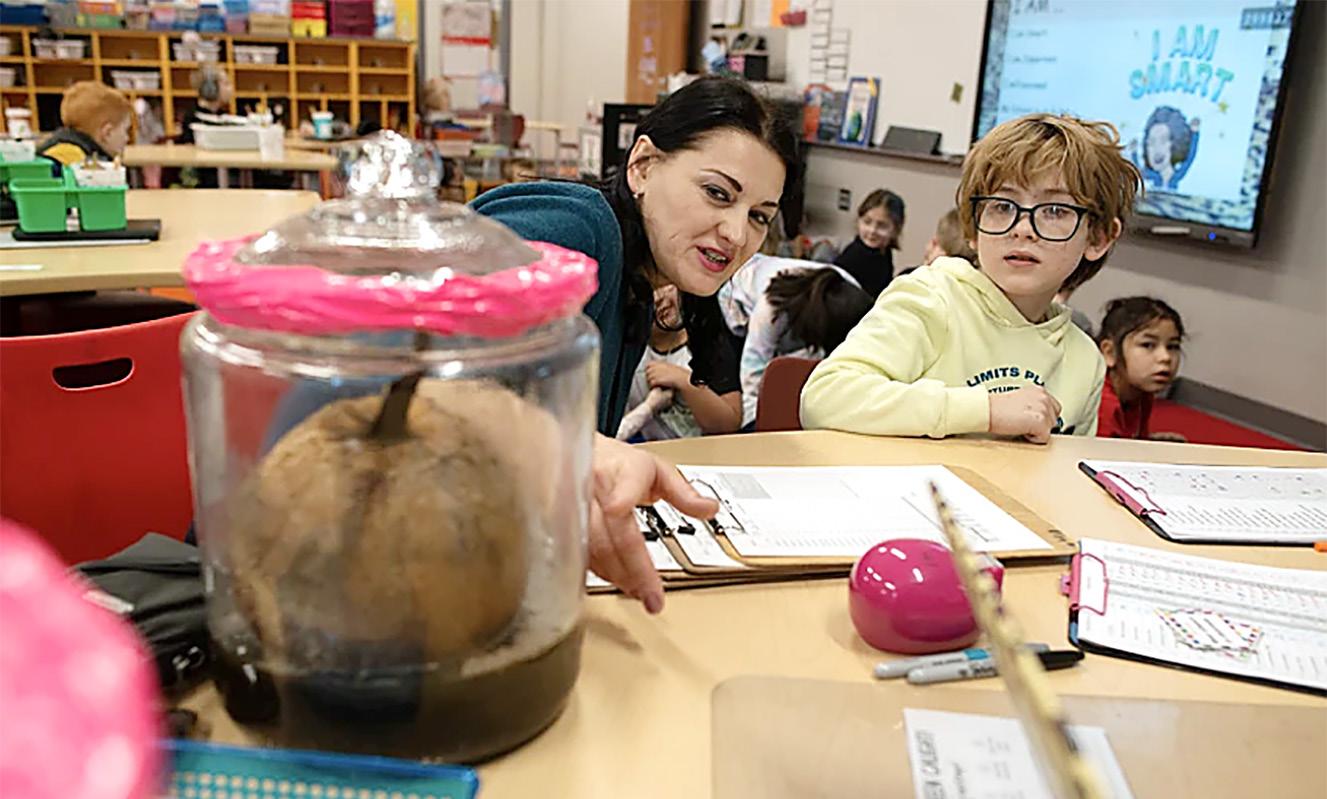
A year after Russia invaded Ukraine and displaced millions of Ukrainians, Mostova and her daughter, Mariia, a 4th grader at Jardine Elementary, and her son, Bohdan, who’s enrolled in kindergarten, feel safe in their new home.
But she is still often gripped with worry for her grandfather, who is still in Ukraine, and her husband Andrii, who is serving in the military. Her heart “is always aching for them [and] for the country,” Mostova said through a translator.
Mostova is one of eight adult refugees— most of them parents or relatives of Ukrainian children—who work in Topeka public schools, part of a concerted district effort to hire the family members of refugee students as employees and volunteers to help ease them into life in a new country. It’s also a way to help families gain financial stability and begin planning for the future.
Through early February, nearly 30 Ukrainian students had enrolled in the district, from kindergarten through high school. Their family members work as paraprofessionals, in food services, and in custodial services, according to the district.
“Economic stability and prosperity [are] a right—it’s not a gift,” said Tiffany Anderson, the superintendent. “It’s something that we all should see as a right that we all should be able to have as human beings. We should all be able to live and prosper.”
When Topeka created a new director of cultural innovation position last summer, Anderson and her team weren’t sure how the district would help meet the needs of students it hadn’t previously served in large numbers. Only five Ukrainian students had enrolled

at the time, and the district did not have a Ukrainian- or Russian-speaking teacher on staff.
But the district already had a newcomer program, and Spanish is the primary second language in the district. Luckily, Anderson said, about 15 years ago the school system had a Ukrainian foreign exchange program, and it was able to get a retired Russian teacher to help out.
After connecting with Yana Ross, a risk manager who is leading the volunteer refugee taskforce in Topeka, the district realized it needed to create more supports to help students and their families gain a foothold.
One of the things it did was create a feeder pattern for Ukrainian students. The district’s newcomer program, for newly arrived immigrant students, is located at Jardine Middle School, so it made the decision to enroll all incoming Ukrainian elementary students at Jardine Elementary, the feeder school attached to the middle school. High school students would go to Topeka High School, where the dual-language program is based.
The feeder pattern allowed the district to use a single bus to pick up and drop off Ukrainian students—including high schoolers, who aren’t normally bused— so that students would also have a chance to socialize on their way to school. It also minimized the possibility that there would be only one Ukrainian student in a building, Anderson said.
“We knew that those schools could certainly sustain those families,” Anderson said. “That meant our social workers, our nurses, all of our staff members that were already present in [those] schools could wrap services around in a concentrated way, at that particular building.”
The feeder pattern also helped Ross to concentrate house hunting for refugee families near the schools, Anderson said.
Technology expansion during the pandemic, which made it easier for districts to provide hotspots and laptops to students, also allowed families to connect to their loved ones in Ukraine as soon as they settled.
“It was a huge, huge blessing,” Ross said.
PilarMejía,
the director of cultural
 By Shayndel Jones WIBW
By Shayndel Jones WIBW
TOPEKA, Kan. (WIBW) - Topeka Public Schools USD 501 students exceeded 103 million words and 39,700 literacy hours.

Topeka Public Schools said the U.S. is facing a reading crisis. The National Assessment of Education Progress (NAEP) reported that only 32% of 4th-grade students could read proficiently in 2022.
Topeka Public Schools has been working to beat these odds. In the 2021-23 school years, USD 501 has focused on making educational investments to prepare children for academic success at home and in school. Thanks to an innovative, bilingual program, USD 501 pre-K through 3rd-grade students read more than 103 million words and read for over 39,700 hours during the 2021-23 school years.
Two years ago, Topeka Public Schools selected Footsteps2Brilliance, a bilingual early literacy solution, to create a proactive model for accelerating kindergarten readiness and 3rdgrade reading proficiency. Footsteps2Brilliance is a standards-aligned, game-based solution available in English and Spanish that personalizes instruction and is available to students and their parents via mobile devices.
As of March 2023, Topeka Public Schools students have achieved a 10-point increase in Phonological Awareness, more than a 5-point increase in Phonics and Language, a 6-point increase in Reading Comprehension, and more
than a 4-point gain in Logic and Reasoning.
“Footsteps2Brilliance has been a wonderful program to develop the reading and writing skills of our PreK-3 grade students. Students love the programs, and teachers see the program’s impact on student learning,” said Robin Dixon, PreK-5 ELA/SS Consulting Teacher.
“We began our work in USD 501 with the focus of building their foundational literacy and reading scores. I am so proud of the outstanding work that their teachers, students, and families have done to fulfill Topeka’s transformative vision. We are
honored to be their partner in this endeavor,” said Ilene Rosenthal, CEO, Footsteps2Brilliance. Enlisting the support of families, schools, and community partners is at the heart of USD 501’s strategic vision to create an equitable birth through the 3rd-grade ecosystem. And the impact is clear. Topeka Public Schools is seeing significant literacy gains and developing a model for early childhood that can be adopted in other leading school districts to address learning loss and accelerated reading proficiency.
TOPEKA, Kan. (WIBW) - After a half-decade uphill climb for full accreditation, Topeka Public Schools has finally reached the milestone for Kansas Educational Systems.
Topeka Public Schools USD 501 says the Accreditation Review Council convened in May and June to review systems for KESA Accreditation for the upcoming school year.

TPS said the ARC has decided to recommend it be accredited as a result of the district’s continuous improvements and growth. It said the accreditation was gained after half a decade of highlighting progress in multiple areas.

When Superintendent Dr. Tiffany Anderson started in 2016, the District said she led the effort to create and implement a new strategic plan which led to the 2022 full accreditation recommendation.
USD 501 noted that the Kansas State Board of Education will take action on the move at its July 12 meeting with Dr. Anderson and other TPS officials in attendance.
“Receiving full accreditation status is a testament to the continued hard work, dedication, and support from the Topeka Public School District Board of Education, staff, students, and families who are committed to providing a high-
quality education for all students,” Dr. Anderson said. “We are grateful for the recognition and are already working on the added gains ahead over the following years.”
TPS indicated some of the achievements it has attained over the past five years include, but are not limited to:
Doubled college course offerings
Increased student attendance, academic

Implementation of a district-wide socialemotional curriculum that has improved mental health services
Most recently, TPS said it received its fifth national Magna Award from the National School Board Association for its PreK - 12 Dual Language Program.
Dr. C. Richard Bonebrake, Board Member
Lalo Muñoz, Board Member
Lisa Schmitt, Board Member
Dr. Randall Schumacher, Board Member
Keith Tatum, Board Member
Dr. Tiffany Anderson, Superintendent of Schools
